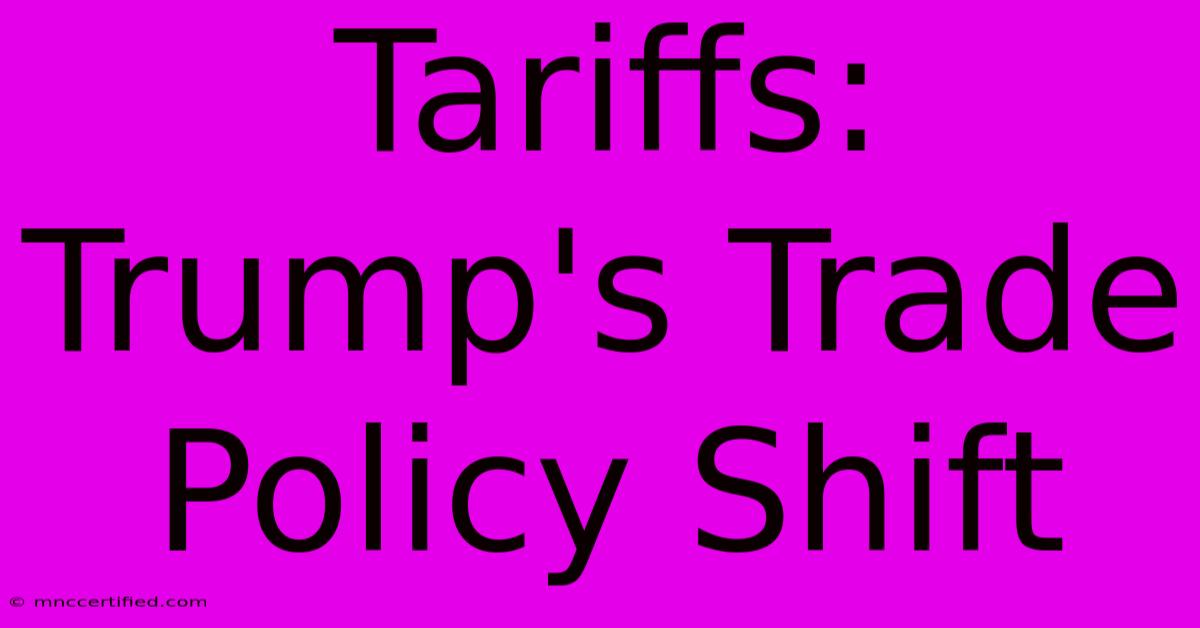Tariffs: Trump's Trade Policy Shift

Table of Contents
Tariffs: Trump's Trade Policy Shift and its Lasting Impact
Donald Trump's presidency marked a significant shift in US trade policy, characterized by a dramatic increase in tariffs on imported goods. This move, touted as a means to protect American industries and jobs, sparked considerable debate and had far-reaching consequences for the global economy. This article delves into the details of Trump's tariff strategy, its intended goals, its actual effects, and its lingering impact on international trade relations.
The Rationale Behind the Tariffs: "America First"
Trump's trade policy was fundamentally rooted in his "America First" ideology. He argued that previous administrations had engaged in unfair trade practices, allowing other countries to exploit the US economy through unfair trade deals and manipulating currency values. He believed that imposing tariffs would:
- Level the playing field: Tariffs were presented as a necessary tool to counter what Trump deemed unfair trade practices, such as dumping (selling goods below cost) and subsidies.
- Protect American jobs: By making imported goods more expensive, the administration aimed to bolster domestic manufacturing and create jobs in the US.
- Reduce the trade deficit: A key objective was to shrink the US trade deficit with countries like China.
These stated goals, however, were met with skepticism from many economists and international trade experts.
Specific Target Sectors: Steel, Aluminum, and China
Trump's tariff strategy wasn't applied uniformly. Specific sectors became focal points, most notably:
- Steel and Aluminum: Early on, broad tariffs were imposed on steel and aluminum imports, impacting allies and adversaries alike. This sparked international backlash and retaliatory tariffs.
- China: The most significant and sustained tariff battles involved China. A trade war erupted, with escalating tariffs on a wide range of goods exchanged between the two countries. This included consumer goods, agricultural products, and technology.
The Impact of Trump's Tariffs: Winners and Losers
The economic consequences of Trump's tariffs were complex and far-reaching, affecting various stakeholders differently:
- American Consumers: Tariffs increased the price of imported goods, leading to higher costs for consumers. This inflationary pressure particularly affected lower-income households, who spend a larger portion of their income on consumer goods.
- American Businesses: While some US industries benefited from increased protection, many others faced higher input costs due to tariffs on imported raw materials and intermediate goods. This hampered competitiveness and hindered economic growth.
- Global Economy: The trade war disrupted global supply chains, reducing international trade and investment. It also led to retaliatory tariffs from other countries, negatively impacting global economic growth.
Unintended Consequences and Economic Fallout
Beyond the direct impacts, Trump's tariff policy had several unintended consequences:
- Retaliatory Tariffs: The imposition of US tariffs provoked retaliatory measures from numerous countries, creating a tit-for-tat trade war that hurt both US and global economies.
- Supply Chain Disruptions: Companies scrambled to adjust their supply chains, leading to increased costs and delays.
- Increased Uncertainty: The unpredictable nature of Trump's trade policy created uncertainty for businesses, discouraging investment and hindering long-term planning.
The Long-Term Effects and Lessons Learned
Trump's trade policy left a lasting mark on US trade relations and the global economic landscape. The long-term effects are still unfolding, but some key lessons can be learned:
- The Complexity of Trade: Trade is a complex issue with far-reaching consequences. Simple solutions, like imposing tariffs, often lead to unintended negative outcomes.
- The Importance of International Cooperation: International cooperation and multilateral trade agreements are crucial for managing trade disputes and fostering global economic growth.
- The Need for Evidence-Based Policy: Trade policy decisions should be based on sound economic analysis and data, rather than on ideological considerations.
While the Trump administration's tariff strategy aimed to reshape global trade in favor of the US, the actual results were mixed and often detrimental to both domestic and international economies. The experience serves as a cautionary tale about the perils of protectionist trade policies and underscores the importance of a more nuanced and multilateral approach to international trade.

Thank you for visiting our website wich cover about Tariffs: Trump's Trade Policy Shift. We hope the information provided has been useful to you. Feel free to contact us if you have any questions or need further assistance. See you next time and dont miss to bookmark.
Featured Posts
-
Riverside Insurance Agency Inc
Nov 27, 2024
-
Austin Life Insurance Policies
Nov 27, 2024
-
Champions League Livestream Man City Feyenoord
Nov 27, 2024
-
Champions League Barcelonas Lineup Vs Brest
Nov 27, 2024
-
Legal Guardian Shares Wendys Status
Nov 27, 2024